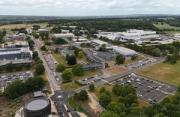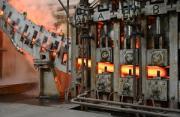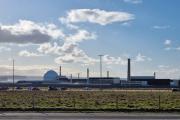UKAEA Responds To Inaccurate And Misleading Report On Particles
3rd September 2006
A number of inaccurate and misleading statements about radioactive particles in the marine environment around Dounreay have been published today in an article in the Daily Telegraph.
UKAEA believes it is important the public has access to accurate and balanced information about particles and the risk they pose, so that people can make informed judgements about the use of beaches etc.
Information about radioactive particles can be found at:
http://www.ukaea.org.uk/sites/dounreay_particles.htm
http://www.ukaea.org.uk/sites/dounreay_particles.htm
http://www.sepa.org.uk/radioactivity/dounreay/index.htm
http://www.sepa.org.uk/radioactivity/dpag/index.htm
http://www.comare.org.uk/press_releases/comare_pr08.htm
UKAEA today is writing to the Daily Telegraph to seek clarification of the following errors contained in its report:
Nobody knew about the contamination of Sandside Beach when Sandside
Estate was bought by Mr Minter in 1990.
FACT: The discovery of radioactive contamination at Sandside in 1984 was
recorded in at least 17 different newspaper reports at the time. The
particle find was reported in official bulletins published by the
Scottish Office from 1984 onwards.
In 1997, Mr Minter was informed that the beach had been fenced off
after routine monitoring uncovered a radioactive particle
FACT: The beach has remained opened to the public since the first
particle find in 1984 and no attempt to restrict access, including
the erection of fences, has been made by UKAEA.
Serious accidents were covered up by the Official Secrets Act
FACT: Any incident at Dounreay has been reported to regulators or
Ministers as required under our statutory obligations and there has
been no cover-up under the Official Secrets Act.
Pieces of plutonium fuel rods found on beach
FACT: The particles are fragments of irradiated uranium fuel rods known
to have originated in the reprocessing works at Dounreay.
A judicial review in 2003 found that the plant had failed in its duty of care by contaminating the landscape. Dounreay then began regular monitoring.
FACT: Sandside Beach has monitored since the start of operations at
Dounreay in the 1950s, since it was recognised as a possible
destination for pollution from the site. Routine monitoring of
Sandside for particles commenced in 1984.
FACT: The Court of Session rejected a demand for additional monitoring
of the beach by UKAEA and left it to SEPA to determine the level of
monitoring required.
UKAEA was fined �2 million last month over a radioactive spillage
FACT: The Nuclear Decommissioning Authority decided to withhold �2
million in commercial fee payable to UKAEA under its contract with
NDA for delivery of the site decommissioning prohramme.
Herbie Lyall was an inspector at the plant
FACT: Mr Lyall was not an inspector at the plant. He was employed by
UKAEA to carry out radiation surveys, as were many others.
Some of the plutonium particles have a half-life of 300 years
FACT: The particles found on beaches are detected by their caesium-137
content, which has a half-life of 30 years.
Scottish Environment Protection Agency signs warn visitors to Sandside of the dangers of radiation
FACT: Sandside Estate decided to erect its own signs at Sandside Beach
after considering the wording agreed for public information signage
provided by SEPA, UKAEA, NHS Highland and Highland Council.
Related Businesses
Related Articles
UKAEA develops 3D printing for fusion components
At its recently opened Central Support Facility (CSF), UKAEA has commissioned an electron beam additive manufacturing machine that can be used to incorporate tungsten into components, alongside a selective laser manufacturing machine. Fusion can play a key role in a global low carbon energy future.Advancing Fusion Remote Maintenance: Industry Collaboration Driving Innovation
As part of the Fusion Futures (FF) programme, UKAEA's Remote Applications in Challenging Environments (RACE) has partnered with industry leaders to develop two groundbreaking technologies for remote maintenance in fusion energy engineering. Thanks to FF funding, industry has taken the lead in maturing UKAEA technology concepts—delivering real-world solutions that enhance operational autonomy and reduce maintenance burdens in extreme environments.UKAEA launches International Fellowships Scheme for fusion
UKAEA has launched the International Fellowships Scheme, an initiative to help expand the global talent pool supporting the fusion industry. The scheme is part of the UKAEA's Fusion Opportunities in Skills, Training, Education and Research (FOSTER) Programme, which aims to train, support, and empower the next generation of professionals, who will help deliver fusion power to the grid.Kyoto Fusioneering and Astral Systems join Culham fusion hub
UKAEA's Culham Campus welcomes Kyoto Fusioneering and Astral Systems as its latest tenants. Two pioneering companies, Kyoto Fusioneering and Astral Systems, have joined the growing cluster of fusion technology and AI organisations at United Kingdom Atomic Energy Authority's (UKAEA) Culham Campus.
Fusion-grade Steel Produced At Scale In UK-first
Researchers achieve 10x production cost savings for reduced activation steel. A United Kingdom Atomic Energy Authority (UKAEA) working group has successfully demonstrated the industrial scale production of fusion-grade steel.
UKAEA To Lead The Creation Of A Robotics And AI Cluster
UKAEA will lead the creation of a new £4.9m nuclear robotics and artificial intelligence cluster across Cumbria and Oxfordshire. The robotics and AI cluster was announced by UK Research and Innovation (UKRI) as one of seven new projects to kickstart economic growth and address regional needs: www.ukri.org The robotics and AI cluster will link Cumbria and Oxfordshire to accelerate the decommissioning of the UK's legacy nuclear fission facilities and keep people out of hazardous environments.
Diamonds Are Forever? World-first Carbon-14 Diamond Battery Made In Uk
The world's first carbon-14 diamond has been produced with the potential to provide power for thousands of years. Scientists and engineers from the UK Atomic Energy Authority (UKAEA) and the University of Bristol have successfully created the world's first carbon-14 diamond battery.
UKAEA Monthly Newsletter Latest Edition
Find out what has been happening at UKAEA in our monthly newsletter. Read about our recent activities and upcoming events.
UKAEA Newsletter - Edition 11 Published Today
Find out what has been happening at UKAEA in our monthly newsletter. Read about our recent activities and upcoming events.
Corwm Visits Dounreay Nuclear Site
Members were given an overview of the scale of the problem and challenges faced in the decommissioning of the site. In the last week of March 2024, several members of CoRWM led by the Chair, Sir Nigel Thrift, made the long journey up to the North of Scotland to visit the Dounreay nuclear site, now managed by Nuclear Restoration Services.
